 Granitos de Maceira, sa
Granitos de Maceira, sa
Founded on June 1944, this company started with 12 man craft workers.
Followed by a period of acquisitions of polishing machinery.
On 1946 the first modern gangsaw equipment arrived and the quarries of limestone and marble were opened, in particular at Alentejo area.
Only on 1956 the Company initiates its activity on granite quarrying.
Francisco Ramos, the founder’s son, succeeded his father, and started the modernization of the company management and the equipment of the factory and quarries.
In consequence Granitos de Maceira achieved an International recognition and became the main exporter of Portuguese granite, more than 60%.
Japan , China , Middle East ,USA , Germany and other European countries were our main market.
Besides our factory at Maceira, Sintra, with a covered area of 9.660 m2 implanted on a total area of 55.000 m2, where we gangsaw the blocks and process slabs, all the way, trough the final product we have our owned quarries:
(1) Alpalhão, Nisa
• Covered area 1800m2 and total of 126 ha;
• This grey granite “SPI-Alpalhão” has a small grain and a high mechanical resistance;
• Great extraction possibility, there were times of more than 1000m3 a month productions;
• For the last 40 years it was very popular specially on Japanese and more recently Chinese markets due to the small grain and homogeneity;
• Besides some significant projects in Portugal like Gare do Oriente and others, SPI has been used by projects such as .
(2) Alagoa
• With an area of 23.8 ha, this quarry produces “Alagoa Grey” a grey , medium grain hard granite.
(3) Santa Eulália
• “Cinzala” is a grey, medium grain of high resistance granite, implanted on 23 ha and a covered area of 700 m2.
(4) Castelo de Vide
• White, large grain granite “Caravela” Allows large blocks extraction on a 21 ha property.
(5) Monforte
• 8 ha of area, this quarry produces a heavy pink granite “Rosa Monforte”. It has been used in large projects on the Emirates like Ethisalat’s.
(6) Torrão
• “Robrato” is a very special stone of red/brownish color and also appreciated by its physical properties and mechanical behavior.
• It has been very much used at Japan where Ibaraky Museum is a good example.
After a period of restructuration, the activity and the financial area, the company left its traditional family management and adopt a more professionalized one. This change has generated a much more competitive action of the company.

